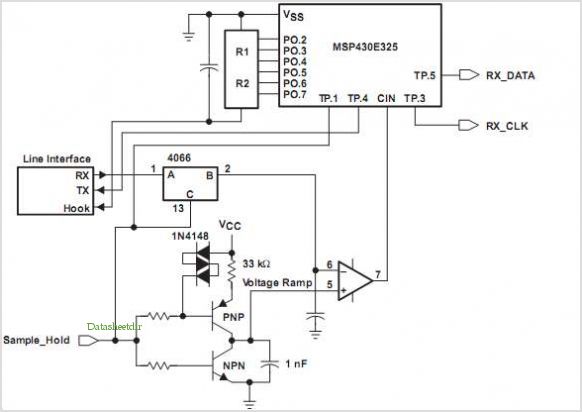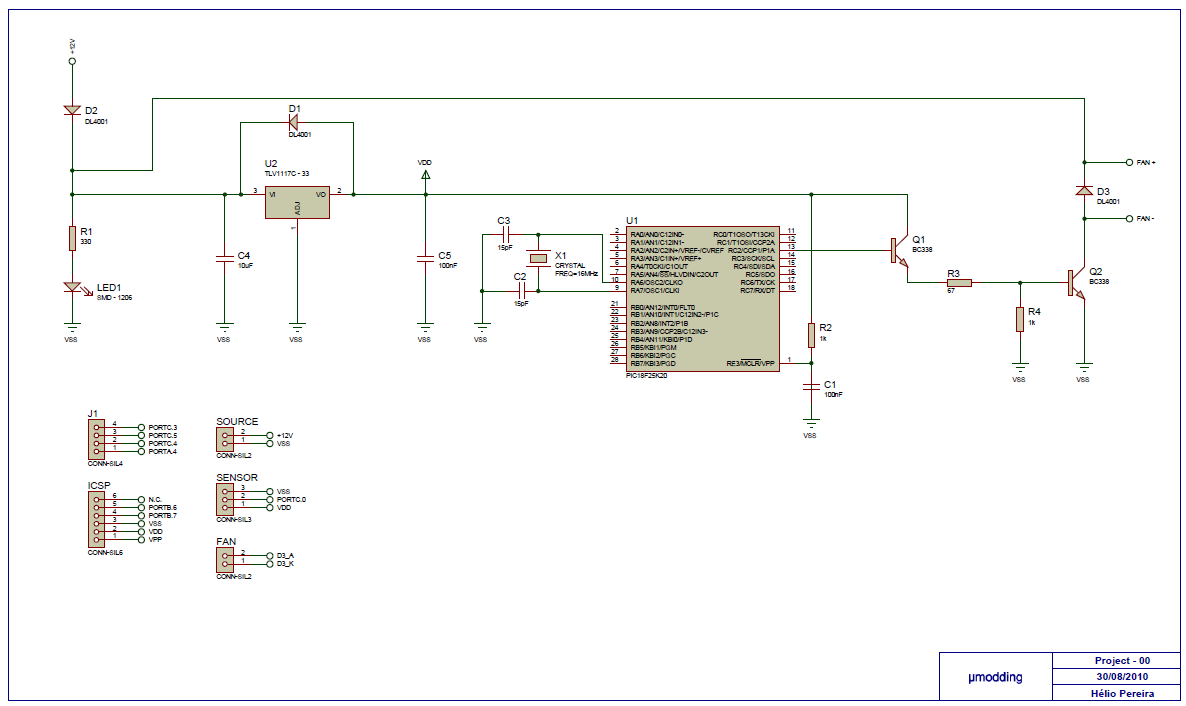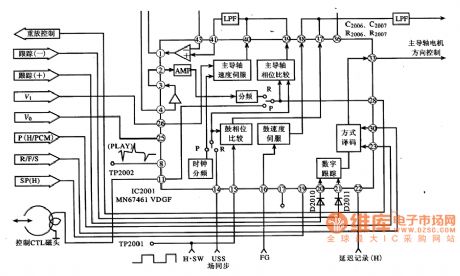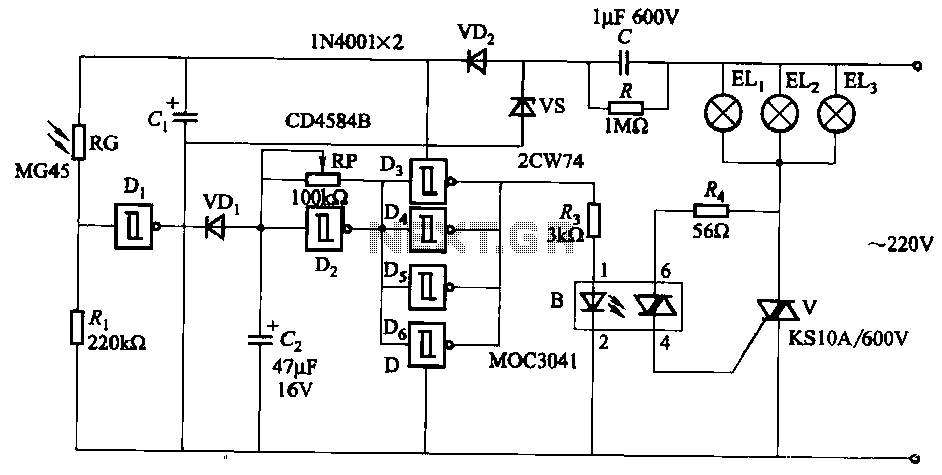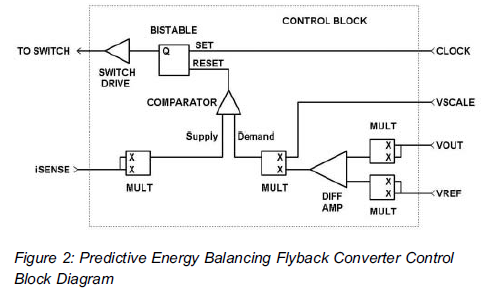
Water-Level Control
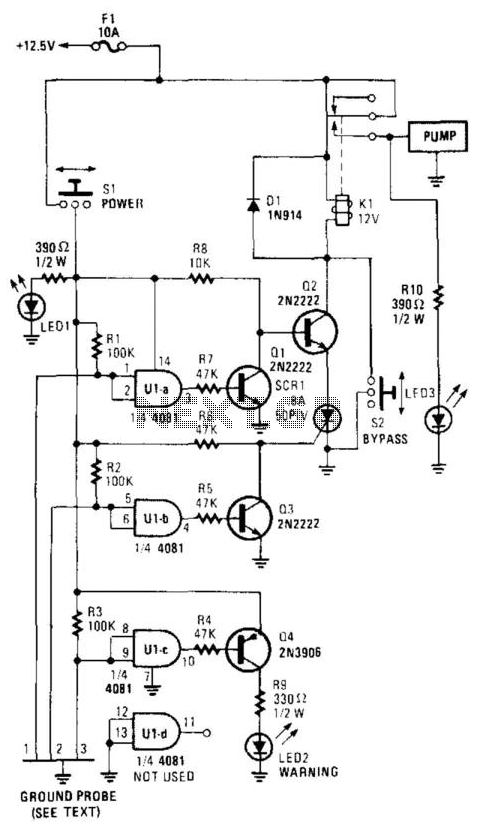
This circuit powers a water pump when the water reaches a predetermined level and turns off when the water recedes to another predetermined point. Gates U1A through U1C have their two inputs tied together and serve as probes placed at various levels to trigger specific functions at predetermined times. The ground side of the circuit is positioned below the minimum water level. Each gate's inputs are tied high through a 100-KOhm resistor connected to the +12.5 V bus. As the water level rises to probe 1, the input to U1A is pulled low due to current conduction through the water to the ground probe, turning Q1 off and Q2 on. With Q2 activated, the circuit enters standby mode, ready to activate the pump when conditions are suitable. Probe 2 is positioned at the maximum water level. If the water level reaches probe 2, the input of U1B is brought low, turning Q3 on, which allows current to flow to the gate of SCR1, activating it. The circuit through K1, Q2, and SCR1 is now complete to ground, turning on the water pump and causing the water level to recede. When the water level falls below probe 2, U1B returns to a logic high. However, due to the latching nature of SCR1, the pump continues to operate until the water level drops below probe 1. At this point, the ground circuit opens, de-energizing K1 and turning off the pump. The pump will not reactivate until the water level rises above probe 2 again. Probe 3 serves as a warning indicator; if the water level reaches probe 3, LED2 lights up to indicate that the pump is not functioning. Switch S2 provides a manual override, while S1 powers the sensing circuit. LED3 shows that power is supplied to the pump, and LED1 indicates that power is applied to the sensor.
This circuit operates as an automated water level control system, utilizing three probes positioned at different heights to monitor the water level. The configuration of gates U1A, U1B, and U1C as voltage probes allows for precise level detection. The use of a 100-KOhm resistor ensures that the inputs to the gates remain high until the water level engages the probes, creating a reliable and responsive system.
When the water level rises to probe 1, the corresponding low signal activates a sequence of events. Q1's deactivation and Q2's activation place the circuit into standby, which is critical for ensuring that the pump does not activate prematurely. The activation of Q3 upon reaching probe 2 is crucial, as it allows SCR1 to latch, ensuring that once the pump is activated, it remains operational until the water level drops below probe 1. This latching mechanism is vital for maintaining pump operation during fluctuating water levels.
The inclusion of probe 3 as a warning system enhances the functionality of the circuit by providing a visual indicator (LED2) when the pump fails to operate, thereby enabling timely maintenance or intervention. The manual override switch S2 offers flexibility for users to control the system manually when necessary, while the status indicators (LED1 and LED3) provide clear visual feedback regarding the operational state of the sensor and pump circuits.
Overall, this water level control circuit is a robust solution for automating water pump operations, ensuring efficient management of water levels with added safety and operational features. This circuit will power up a water pump when the water reaches a predetermined level. Then it turns itself off when the water recedes to another predetermined point. Gates U1A through U1C each have their two inputs tied together, and serve as probes. The probes are then placed at various levels to trigger a particular function at a predetermined time. The ground side of the circuit is placed below the minimum water level. The inputs to each gate are tied high through a 100-KOhmhm resistor connected to the + 12.5-V bus. As the water level slowly rises to probe 1, the input to Ul A is pulled low by the conduction of current through the water to the ground probe.
That turns Ql off and Q2 on. With Q2 turned on, the circuit is placed in the standby mode, ready to activate the pump when conditions are right. Probe 2 is placed at the maximum water level. If the water level reaches probe 2, the input of U1B is brought low, turning Q3 on, which, in turn, causes current to be applied to the gate of SCR1, turning it on.
The circuit through Kl, Q2, and SCR1 is now complete to ground, and the water pump is now turned on, which causes the water level to recede. When the water level falls below probe 2, U1B goes back to logic high. However, because of the latching nature of SCR1, the pump continues to run until the water level falls below probe 1.
At that point, the ground circuit opens and de-energizes Kl, which turns the pump off. The pump will not turn on again until the water level again rises above probe 2. Probe 3 was added as a warning. If the water level reaches probe 3, LED2 indicates that the pump is not working. Switch S2 is a manual override and SI powers the sensing circuit. LED3 indicates that power has been applied to the pump. LED1 indicates that power has been applied to the sensor. 🔗 External reference
This circuit operates as an automated water level control system, utilizing three probes positioned at different heights to monitor the water level. The configuration of gates U1A, U1B, and U1C as voltage probes allows for precise level detection. The use of a 100-KOhm resistor ensures that the inputs to the gates remain high until the water level engages the probes, creating a reliable and responsive system.
When the water level rises to probe 1, the corresponding low signal activates a sequence of events. Q1's deactivation and Q2's activation place the circuit into standby, which is critical for ensuring that the pump does not activate prematurely. The activation of Q3 upon reaching probe 2 is crucial, as it allows SCR1 to latch, ensuring that once the pump is activated, it remains operational until the water level drops below probe 1. This latching mechanism is vital for maintaining pump operation during fluctuating water levels.
The inclusion of probe 3 as a warning system enhances the functionality of the circuit by providing a visual indicator (LED2) when the pump fails to operate, thereby enabling timely maintenance or intervention. The manual override switch S2 offers flexibility for users to control the system manually when necessary, while the status indicators (LED1 and LED3) provide clear visual feedback regarding the operational state of the sensor and pump circuits.
Overall, this water level control circuit is a robust solution for automating water pump operations, ensuring efficient management of water levels with added safety and operational features. This circuit will power up a water pump when the water reaches a predetermined level. Then it turns itself off when the water recedes to another predetermined point. Gates U1A through U1C each have their two inputs tied together, and serve as probes. The probes are then placed at various levels to trigger a particular function at a predetermined time. The ground side of the circuit is placed below the minimum water level. The inputs to each gate are tied high through a 100-KOhmhm resistor connected to the + 12.5-V bus. As the water level slowly rises to probe 1, the input to Ul A is pulled low by the conduction of current through the water to the ground probe.
That turns Ql off and Q2 on. With Q2 turned on, the circuit is placed in the standby mode, ready to activate the pump when conditions are right. Probe 2 is placed at the maximum water level. If the water level reaches probe 2, the input of U1B is brought low, turning Q3 on, which, in turn, causes current to be applied to the gate of SCR1, turning it on.
The circuit through Kl, Q2, and SCR1 is now complete to ground, and the water pump is now turned on, which causes the water level to recede. When the water level falls below probe 2, U1B goes back to logic high. However, because of the latching nature of SCR1, the pump continues to run until the water level falls below probe 1.
At that point, the ground circuit opens and de-energizes Kl, which turns the pump off. The pump will not turn on again until the water level again rises above probe 2. Probe 3 was added as a warning. If the water level reaches probe 3, LED2 indicates that the pump is not working. Switch S2 is a manual override and SI powers the sensing circuit. LED3 indicates that power has been applied to the pump. LED1 indicates that power has been applied to the sensor. 🔗 External reference
Warning: include(partials/cookie-banner.php): Failed to open stream: Permission denied in /var/www/html/nextgr/view-circuit.php on line 713
Warning: include(): Failed opening 'partials/cookie-banner.php' for inclusion (include_path='.:/usr/share/php') in /var/www/html/nextgr/view-circuit.php on line 713
